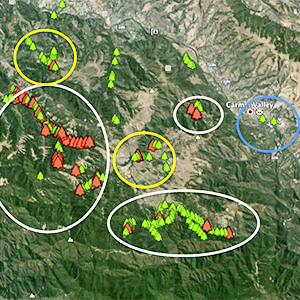Survival of P. ramorum (SOD pathogen) in wood chips depends on a few factors:
- Were the chips allowed to become wet?
- What size are the chips?
- Is green waste present?
- What time of year was the wood chipped?
- Where in California are the chips located?
Chips that are piled wet or tarped and include infected green waste (e.g. bay laurel leaves) may support pathogen viability for over 1 year, especially in mild coastal areas. If the wood is chipped in the summer and early fall and the chips are not piled, but rather broadcast in a 1-inch layer in a dry and sun-exposed area, pathogen viability may only be supported for a few weeks, especially if in hotter interior areas.
SOD Blitzes include a training session for blitz volunteers on SOD and proper sampling, followed by time in the field for collecting and marking sample locations. All necessary collection materials are provided to volunteers during the training session for use either the same day of the training or the day after. All samples are to be dropped off at a designated location (location announced at the training session). There are approximately 20 SOD Blitzes in areas of California that have sudden oak death or at risk of disease establishment. Most of the training sessions are offered on Saturday mornings. SOD Blitz schedules for the coming year are posted annually during the last week of January at www.sodblitz.org.
Leaf tip scorch symptoms on redwood trees are found from the lower to upper canopy and include healthy leaves interspersed with brown and grey leaves or portions of leaves. Grey leaves typically have black margins into the healthy tissue.
Such symptoms are typically caused by a fungus called Pestalotiopsis funerea. They are commonly associated with drought, when rainfall occurs or when there is overhead watering around the tree. Drought stress predisposes plants to being infected, so the increased moisture facilitates the infection process. Normally the fungus will only seriously affect sprouts, as branches of adult tress will regrow areas killed by the infection within a year. In nursery settings it is important to increase ventilation and avoid big differences in watering regimes to minimize symptoms.
Injections may be better for large trees with a regular shape, while topical applications may be better for large, irregular, gnarly trees.
In order to obtain maximum efficacy with oak phosphonate treatments, minimum temperatures should not be below 50 ºF. Maximum daytime temperatures should be higher than 60 ºF, but not exceed 85 ºF.
While phosphonate injections to help control SOD are now recommended once every 2 years, spray applications should still be applied to the bark of oak trees annually.
Once bark beetles attack the main stem (trunk) of an oak, the tree is on its way out. Insecticide treatments will not save it. Oak beetles are attracted to trees that are severely compromised. They cannot attack healthy trees.
The correct approach to avoid bark beetle infestations is not to apply insecticides, but rather to identify any health issues a tree may have. As of October 2015, many trees are suffering from the prolonged drought and may need watering. Watering should be applied infrequently and never during the summer. Water-starved trees may display a thinner crown, with olive-green rather than dark-green leaves. Leaves may also be crisp when folded between your fingers. If you opt to provide water to an oak tree that is severely water deprived, make sure the water reaches a depth of about one foot below the soil surface. Also make sure the flow is low to avoid flooding the base of the tree.
Phosphonate is only intended to be used on trees that do NOT have sudden oak death (SOD). Once a tree is infected, it is of no use. It helps to boost the tree’s own immunity system against the pathogen. So, if a tree is very susceptible to P. ramorum (the pathogen that causes SOD), then it may still get infected and die, even with the phosphonate treatment. Really, the phosphonate just helps increase the odds that a moderately susceptible tree will be able to ward off infection. So, it is an odds game and you are just increasing your odds of success. Variables that contribute to success include tree susceptibility, disease pressure in the area, hosts present in the area, and environmental conditions.
Research has identified coast live oak individuals that may be somewhat resistant to SOD, possibly because of the presence of some chemicals in the bark and phloem. However, there is no information yet on how genetics and the environment may affect this trait.
Tanoak has some mother trees that produce SOD-tolerant seedlings and some that produce seedlings that respond very well to phosphonate treatments. These tanoak families are at UC Berkeley, but are not currently commercially available.








